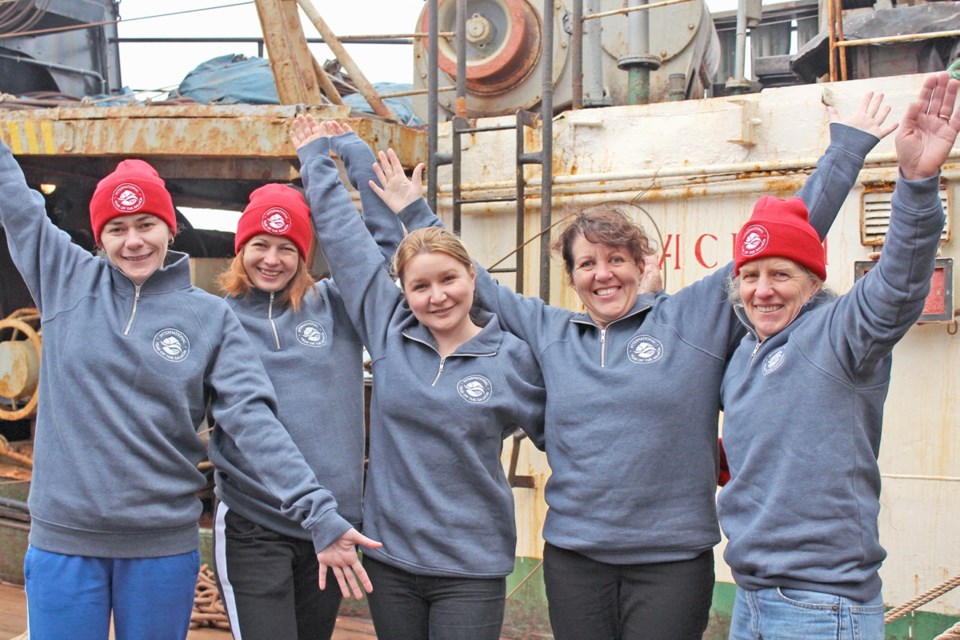A typical day for five female scientists taking part in an international salmon research expedition on the high seas sees them do everything from chemical analyses of water samples to examining their catch to discover secrets of winter survival.
They are in the middle of the Gulf of Alaska, where 21 scientists and 31 crew members have faced seas of three to five metres on board a chartered Russian trawler in a first-of-its-kind research expedition marked by international co-operation.
Despite the distance from land, the women consider today special.
Nanaimo research biologist Chrys Neville said in a statement sent from the ship: “The women on the Professor Kaganovsky wish the women of the world a wonderful International Women’s Day. You go, girl!”
International Women’s Day is celebrated in Russia, where it is a public holiday.
“Obviously it is a regular day of work at sea. However, the men are all congratulating the women on the ship for this day,” Neville said.
Another four women on the trawler are crew members, who “all measure their sea time in decades,” writes Neville, who, along with her own research, also heads up communication from the ship.
The expedition was organized by Richard Beamish, a fisheries biologist in Nanaimo. It brings together scientists from Russia, Japan, Korea, the United States and Canada. Beamish raised $1.3 million to fund the survey, which started in February and finishes this month.
Scientists are teaming up to learn where and how Pacific salmon — important to all five countries — spend their winters after leaving their home streams.
Senior scientist Neville, who is based at Federal Fisheries and Oceans Canada’s Pacific Biological Station, has more than 25 years’ experience leading field research programs studying the marine ecology of juvenile Pacific salmon.
Neville, who began research on ships in 1990, said: “I never expected my next trip to be to the middle of the Northeast Pacific in the middle of winter.
“However, I always say that I want to explore the world, and this is definitely an area that only science could take me!”
This trip provides the opportunity to augment her research on sockeye and chinook salmon normally studied closer to the coast.
American Laurie Weitkamp, who is serving as the chief scientist when the ship is in U.S. waters, began research on ships in 1991. She is internationally recognized for work on the ocean ecology of Pacific salmon.
While Russia has a long tradition of women serving at sea as scientists and part of the crew, that was not the case on North American research ships, Neville said.
Early in their careers, Neville and Weitkamp were often the only women on research ships.
“However, things have changed dramatically over the last 20 years,” Neville said. “Today women serve in all positions, including ship officers, engineers, crew and scientists.
“On several surveys I had led over the last five years, 80 per cent of the science crew has been female.”
The female scientists on the Professor Kaganovsky agree there is more equality on ships these days. “But for some things, women are still being treated differently,” Neville said.
“For example, many men automatically assume women are too weak to do any heavy lifting, or their upbringing suggests that they should offer to do it for a woman. However, generally after a few days working as a team, these stereotypes disappear.”
Canada’s other representative is Svetlana Esenkulova of the Vancouver-based Pacific Salmon Foundation, a biological oceanographer who is collecting DNA and also studying squid, a key food for salmon.
Anna Vazhova, a hydrochemist from Russia, does all the chemical analyses of water samples collected at each station.
“What makes this expedition special is that everyone is excited to be here,” she said.
Albina Kanzsparova, also from Russia, is keen to see how salmon stocks are formed in both sides of the ocean, what processes define the stocks, what factors they have in common and what are found in specific regions.
Neville said the female scientists note that everyone is working well together and are enthusiastic about participating in the expedition, where they share the excitement of discovery.
“We’re actually seeing what is out here and the dynamics of this region, rather than just guessing what these fish are doing,” she said.
“The passion for the science that is being conducted and simply having the opportunity to be part of this expedition is readily apparent for all participants, men and women alike.”



